The pig sector is the third most important agricultural sector in Ireland after milk and beef. Its total contribution to the Irish economy is valued at almost €1.5bn.
There are over 8,000 jobs in the sector, mostly in rural areas, and an annual pig sector economy spend of almost €900m.
The financial crisis in the sector during 2021 and 2022 has taken its toll.
Sow numbers in Ireland have decreased by almost 9% to 134,000 sows, the lowest number since the late 1980s.
Pig production declined by 11%. This is reflected across Europe, with the European breeding herd down 9.3%, to 9.45m sows. As a result, exports from Ireland have decreased by 17%, while exports from Europe have dropped by 19% over 2022 figures.
This contraction has seen a return to profitability, with a significant rise in pig prices in 2023, reaching record levels at €2.38/kg deadweight in August/September.
Worryingly, prices took a significant turn from October, with seven price drops in a 10-week period before Christmas, resulting in an average price of €2.24/kg deadweight for the year.

Exports from Ireland have decreased by 17%, while exports from Europe have dropped by 19% over 2022 figures.
There were two more price drops in January, but prices seem to have bottomed out since then with a welcome rise last week, giving a current pig price of €2.07/kg deadweight at present.
Composite feed price
Thankfully, feed prices improved throughout 2023, with the composite feed price dropping from €480/t in January to €396/t in December (averaging €439/t for the year).
Feed prices were holding their own over the last few months but, in recent weeks, feed ingredient prices are starting to fall with good value available for buying forward to the end of 2024.
The welcome rise in pig prices and fall in feed ingredient prices should see continued profitability in 2024, albeit at a lower level than in 2023.
This is much needed for a sector that has endured a lot and needs time and profit to reinvest in their farms and secure their futures.
The pig sector is the third most important agricultural sector in Ireland after milk and beef. Its total contribution to the Irish economy is valued at almost €1.5bn.
There are over 8,000 jobs in the sector, mostly in rural areas, and an annual pig sector economy spend of almost €900m.
The financial crisis in the sector during 2021 and 2022 has taken its toll.
Sow numbers in Ireland have decreased by almost 9% to 134,000 sows, the lowest number since the late 1980s.
Pig production declined by 11%. This is reflected across Europe, with the European breeding herd down 9.3%, to 9.45m sows. As a result, exports from Ireland have decreased by 17%, while exports from Europe have dropped by 19% over 2022 figures.
This contraction has seen a return to profitability, with a significant rise in pig prices in 2023, reaching record levels at €2.38/kg deadweight in August/September.
Worryingly, prices took a significant turn from October, with seven price drops in a 10-week period before Christmas, resulting in an average price of €2.24/kg deadweight for the year.

Exports from Ireland have decreased by 17%, while exports from Europe have dropped by 19% over 2022 figures.
There were two more price drops in January, but prices seem to have bottomed out since then with a welcome rise last week, giving a current pig price of €2.07/kg deadweight at present.
Composite feed price
Thankfully, feed prices improved throughout 2023, with the composite feed price dropping from €480/t in January to €396/t in December (averaging €439/t for the year).
Feed prices were holding their own over the last few months but, in recent weeks, feed ingredient prices are starting to fall with good value available for buying forward to the end of 2024.
The welcome rise in pig prices and fall in feed ingredient prices should see continued profitability in 2024, albeit at a lower level than in 2023.
This is much needed for a sector that has endured a lot and needs time and profit to reinvest in their farms and secure their futures.







 This is a subscriber-only article
This is a subscriber-only article










SHARING OPTIONS: